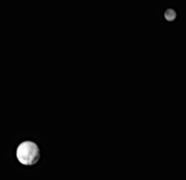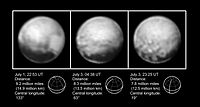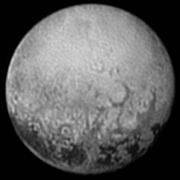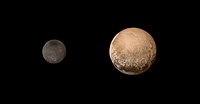New Horizons
This article or section documents a current or recent spaceflight. Details may change as the mission progresses. Initial news reports may be unreliable. The last updates to this article or section may not reflect the most current information. For more information please see WikiProject Spaceflight. |
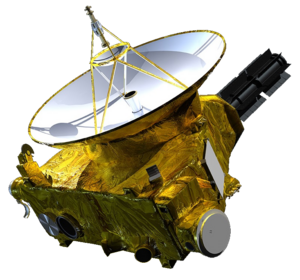 The New Horizons space probe | |||||||||||||||||
| Mission type | Pluto flyby | ||||||||||||||||
|---|---|---|---|---|---|---|---|---|---|---|---|---|---|---|---|---|---|
| Operator | NASA | ||||||||||||||||
| COSPAR ID | 2006-001A | ||||||||||||||||
| SATCAT no. | 28928 | ||||||||||||||||
| Website | pluto www.nasa.gov | ||||||||||||||||
| Mission duration | Primary mission: 9.5 years | ||||||||||||||||
| Spacecraft properties | |||||||||||||||||
| Manufacturer | APL · Southwest Research Institute | ||||||||||||||||
| Launch mass | 478 kilograms (1,054 lb) | ||||||||||||||||
| Power | 228 watts | ||||||||||||||||
| Start of mission | |||||||||||||||||
| Launch date | January 19, 2006 19:00 UTC (18 years, 7 months and 27 days ago) | ||||||||||||||||
| Rocket | Atlas V 551 | ||||||||||||||||
| Launch site | Space Launch Complex 41 Cape Canaveral Air Force Station, Florida, United States | ||||||||||||||||
| Contractor | International Launch Services | ||||||||||||||||
| Flyby of Moon | |||||||||||||||||
| Closest approach | January 20, 2006 04:00 UTC (18 years, 7 months and 26 days ago) | ||||||||||||||||
| Distance | 189,916 km (118,008 mi) | ||||||||||||||||
| Flyby of (132524) APL (incidental) | |||||||||||||||||
| Closest approach | June 13, 2006 04:05 UTC (18 years, 3 months and 2 days ago) | ||||||||||||||||
| Distance | 101,867 km (63,297 mi) | ||||||||||||||||
| Flyby of Jupiter (Gravity assist) | |||||||||||||||||
| Closest approach | February 28, 2007 05:43:40 UTC (17 years, 6 months and 18 days ago) | ||||||||||||||||
| Distance | 2,300,000 km (1,400,000 mi) | ||||||||||||||||
| Flyby of Pluto | |||||||||||||||||
| Closest approach | July 14, 2015 11:49:57 UTC | ||||||||||||||||
| Distance | 12,500 km (7,800 mi) | ||||||||||||||||
| |||||||||||||||||

| |||||||||||||||||
New Horizons is an interplanetary space probe that was launched on January 19, 2006, as part of NASA's New Frontiers program. Built by the Applied Physics Laboratory (APL) and the Southwest Research Institute, with a team led by S. Alan Stern, the spacecraft was launched to study Pluto, its moons and the Kuiper Belt, performing flybys of the Pluto system and one or more Kuiper Belt Objects (KBOs).[1][2][3][4]
New Horizons is the result of many years of work on missions to send a spacecraft to Pluto, starting in 1990 with Pluto 350, with Alan Stern and Fran Bagenal of the "Pluto Underground", and in 1992 with the Jet Propulsion Laboratory's Pluto Fast Flyby; the latter inspired by a USPS stamp that branded Pluto as "Not Yet Explored". The ambitious mission aimed to send a lightweight, cost-effective spacecraft to Pluto, later evolving into a Kuiper Belt Object mission named Pluto Kuiper Express. However, because of underwhelming support from NASA and a growing budget, the project was eventually cancelled altogether in 2000.
Following backlash from the cancellation, the New Frontiers program was established for missions that fit in between the big budgets of the Flagship Program and the low budgets of the Discovery Program. The Applied Physics Laboratory, with a team led by Alan Stern and consisting of former Pluto Kuiper Express team members, won a competition to fund their New Horizons project, based on work left off from Pluto Kuiper Express, under the New Frontiers program. However, funding for the mission was not secured until after a financial standoff between the team and then-NASA Administrator Sean O'Keefe. After three years of construction, and several delays at the launch site, New Horizons was launched on January 19, 2006, from Cape Canaveral, directly into an Earth-and-solar-escape trajectory with an Earth-relative speed of about 16.26 kilometers per second (58,536 km/h; 36,373 mph); it set the record for the highest launch speed of a human-made object from Earth.
After a brief encounter with asteroid 132524 APL, New Horizons proceeded to Jupiter, making its closest approach on February 28, 2007 at a distance of 2.3 million kilometers (1.4 million miles). The Jupiter flyby provided a gravity assist that increased New Horizons' speed by 4 km/s (14,000 km/h; 9,000 mph). The encounter was also used as a general test of New Horizons' scientific capabilities, returning data about its atmosphere, moons, and magnetosphere. Most of the post-Jupiter voyage was spent in hibernation mode to preserve on-board systems, except for brief annual checkouts.[5] On December 6, 2014, New Horizons was brought back on-line for the encounter, and instrument check-out began.[6] On January 15, 2015, the New Horizons spacecraft began its approach phase to Pluto. On July 14, 2015 11:49 UTC (07:49 EDT), the New Horizons spacecraft flew 12,600 km (7,800 mi) from the surface of Pluto.[7] It was the first spacecraft to explore Pluto.[4]
History
Exploring Pluto was contemplated since its discovery by Clyde Tombaugh in 1930. One of many possibilities for the Voyager 1 spacecraft after its flyby of Saturn in 1980 was to use Saturn as a slingshot towards Pluto for a flyby as early as March 1986.[8] However, scientists on the Voyager program penned a flyby of Titan during the Saturn encounter to be a more important scientific objective. A flyby of Pluto was impossible, as not only did the spacecraft make a close approach of Titan, it was also on a trajectory that slingshot the spacecraft upwards out of the ecliptic.[9] Because no mission to Pluto was planned by any space agency at the time, it would be left unexplored by interplanetary spacecraft for years to come. Shortly after Voyager 2's flyby of Neptune and its findings at Triton in August 1989, scientists sought interest in a mission to Pluto and further studies for the existence of a Kuiper Belt and Kuiper Belt Objects, potentially similar to Triton.[10]
The Pluto Underground, Pluto 350 and Mariner Mark II
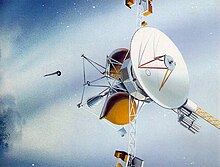
In May 1989, a group of scientists, including Alan Stern and Fran Bagenal, formed an alliance called the "Pluto Underground". It was named in homage of the Mars Underground, another group of scientists that successfully lobbied for the restart of missions to Mars, following the lack of such since the Viking program. The group started a letter writing campaign which aimed to bring to attention Pluto as a viable target for exploration.[11] In 1990, because of pressure from the scientific community, including those of the Pluto Underground, scientists at NASA decided to look into concepts for a mission to Pluto. At the time, it was thought that the atmosphere of Pluto would freeze and fall to the surface during winter, and so a lightweight spacecraft was desirable, as it would be able to reach Pluto before such an event would occur. One of the earliest concepts was for a 40-kilogram spacecraft that would reach Pluto in 5 to 6 years. The idea was shortly scrapped, however, because of the infeasibility of miniaturizing scientific instruments aboard such a spacecraft to that size.[12]
Another mission concept, known as Pluto 350, was developed by Robert Farquhar of the Goddard Space Flight Center, with Alan Stern and Fran Bagenal of the Pluto Underground, who both served as study scientists for the project. Pluto 350 aimed to send a spacecraft, weighing 350 kilograms, to Pluto.[10] The spacecraft's minimalistic design was so to allow it to travel faster and be more cost-effective, in-contrast to most other big-budget projects NASA were developing at the time, such as Galileo and Cassini. Pluto 350, however, would later become controversial among mission planners at NASA, who considered the project to be too small and too high-risk. An alternate plan which was considered at one point was to send to Pluto a configuration of the Mariner Mark II spacecraft, which would weigh 2,000 kilograms and cost US$3.2 billion, in sharp contrast to Pluto 350's $543 million cost.[12] While both projects competed for approval, Pluto 350 was more favored by NASA mission planners, who were starting to adopt smaller missions such as Mars Pathfinder and NEAR Shoemaker.[10]
USPS postage stamp and Pluto Fast Flyby
For many years, people had waved that stamp around as sort of a call to arms, as a motivating graphic: "Not yet explored". That stamp had been in so many presentations by that point, I knew it would please people to have it go along.
S. Alan Stern on the USPS stamp[12]
In October 1991, the United States Postal Service released a series of stamps commemorating NASA's exploration of the solar system. The series featured a stamp for all planets, displaying an image of the planet and highlighting an associated spacecraft which was sent to it. The stamp for Pluto, however, depicted a featureless sphere, presented with the phrase "not yet explored" in place of the name of a spacecraft. The stamps were unveiled in a ceremony at the Jet Propulsion Laboratory. Two scientists who attended the event, World Space Foundation president Robert Staehle and JPL scientist Stacy Weinstein, were inspired by Pluto's status on the stamp; such that they started to inquire about the feasibility of sending a spacecraft to Pluto.[13][14] Engineers at the Jet Propulsion Laboratory who were also inspired by the "Not Yet Explored" status of Pluto started to run ideas about a mission to Pluto as well.[15][16]
In 1992, Staehle, with the help of JPL engineers and students from the California Institute of Technology, formed the Pluto Fast Flyby project. The mission heralded the same ideology as the Pluto 350 concept: small in size and cost-effective in scope, so that the spacecraft would be able to get to Pluto faster and be affordable to develop and launch. Described as a "radical" mission concept, the mission would see two spacecraft being sent to Pluto. Both spacecraft were to weigh only around 35-50 kilograms each (including 7 kg worth of scientific instruments), and the project would cost less than $500 million to develop, excluding launch costs.[13] Described by Staehle as a "faster, better, [and] cheaper" approach than the Pluto 350 and Mariner Mark II projects, it caught the attention of then-NASA Administrator Daniel S. Goldin, who ordered all work on both Pluto 350 and Mariner Mark II to cease and shift all resources to the new Pluto Fast Flyby project instead.[10]
During the development of Pluto Fast Flyby, however, there were multiple concerns from both NASA, Administrator Goldin and the mission's development team. As research and development into the mission progressed, the project's size and scope expanded; its budget growing with it also. Additionally, morale among the team and personnel working on interplanetary missions was low following the loss of the Mars Observer spacecraft during its attempted Areocentric orbit insertion in August 1993; an event that Alan Stern would later cite as a significant factor towards the low enthusiasm for the Pluto Fast Flyby project.[12] The launch of the spacecraft were intended to be performed using Titan IV rockets, which would've cost $400 million each, thus raising the budget over $1 billion.[10] Because of growing budget constraints, the dual-spacecraft concept was scrapped in favor of sending a singular spacecraft to Pluto. However, the project was still too expensive in the eyes of Administrator Goldin.[12] Alan Stern, as a compromise, reached an agreement with Russian Space Research Institute scientists in Moscow, in which Pluto Fast Flyby would be launched atop a Proton rocket, saving NASA over $400 million in launch costs. The proposal was forwarded to Administrator Goldin; however, he refused the proposal, recommending instead that the JPL look into the feasibility of Pluto Fast Flyby being launched aboard a smaller rocket, such as the Delta II.[10]
Kuiper Belt, Pluto Kuiper Express and cancellation

During the course of the late 1990s, a number of Trans-Neptunian objects were discovered, confirming the existence of a Kuiper Belt. Interest in a mission to the Kuiper Belt arose to such that NASA instructed the JPL to re-purpose the mission as not only a Pluto flyby, but also a Kuiper Belt Object (KBO) flyby. The mission was thus re-branded the Pluto Kuiper Express, after briefly being billed as Pluto Express prior to the revision of the mission. The weight of the spacecraft was raised again, this time to 175 kilograms, and NASA allowed further liberty with the project's budget.[10] However, it was later decided by Goldin that Pluto Kuiper Express was of low importance, and thus cut funding to the project drastically. Eventually, despite official selection of scientific instruments and the appointment of several investigators, then-Science Mission Directorate Edward J. Weiler ordered the cancellation of the entire Pluto and Kuiper Belt mission in 2000, citing growing budget constraints, which had plagued the project since its inception in 1992 and, at the time of cancellation, had grown to $1.1 billion.[12][17]
Alan Stern and New Horizons

The cancellation of Pluto Kuiper Express angered most of the scientific community, which led to most groups, such as The Planetary Society, lobbying NASA for a reboot of Pluto Kuiper Express or, at the very least, a restart of a mission to Pluto. Internal divisions within NASA, including its Scientific Advisory Council, also voiced support for a Pluto mission.[12] In response to the backlash caused by the cancellation of Pluto Kuiper Express, Weiler decided to inaugurate a new class of missions that would fit between the big-budget Flagship Program and the low-budget Discovery Program, creating a compromise for missions such as the former Pluto Kuiper Express, which proved to be too expensive for the Discovery Program. A competition was held, in which NASA would select a mission concept to fund as part of the first mission of the New Frontiers program.[17]
Stamatios “Tom” Krimigis, head of the Applied Physics Laboratory's space division, one of many entrants in the New Frontiers Program competition, formed the New Horizons team with Alan Stern in December 2000. Appointed as the project's principal investigator, Stern was described by Krimigis as "the personification of the Pluto mission".[17] New Horizons was based largely on Stern's work since Pluto 350 and involved most of the team from Pluto Kuiper Express.[10] The New Horizons proposal was one of five that were officially submitted to NASA. It was later selected as one of two finalists to be subject to a three-month concept study, in June 2001. The other finalist, POSSE (Pluto and Outer Solar System Explorer), was a separate, but similar Pluto mission concept by the University of Colorado Boulder, led by principal investigator Larry W. Esposito, and supported by the JPL, Lockheed Martin and the University of California.[18] However, the APL, in addition to being supported by Pluto Kuiper Express developers at the Goddard Space Flight Center and Stanford University,[18] were at an advantage; they had recently developed NEAR Shoemaker for NASA, which had successfully entered orbit around 433 Eros earlier in the year, and would later land on the asteroid to scientific and engineering fanfare.[19]
In November 2001, New Horizons was officially selected for funding as part of the New Frontiers program.[20] However, the new NASA Administrator appointed by the Bush Administration, Sean O'Keefe, was not supportive of New Horizons, and effectively cancelled it by not including it in NASA's budget for 2003. Weiler prompted Stern to lobby for the funding of New Horizons in hopes of the mission appearing in the Planetary Science Decadal Survey; a prioritized "wish list", compiled by the United States National Research Council, that reflects the opinions of the scientific community. After an intense campaign to gain support for New Horizons, the Planetary Science Decadal Survey of 2003-2013 was published in the summer of 2002. New Horizons topped the list of projects considered the highest priority among the scientific community in the medium-size category; ahead of missions to the Moon, and even Jupiter. Weiler stated that it was a result that "[his] administration was not going to fight".[17] Funding for the mission was finally secured following the publication of the report, and Stern's team were finally able to start building the spacecraft and its instruments, with a penned launch in January 2006 and arrival at Pluto in 2015.[17]
Mission profile
New Horizons is the first mission in NASA's New Frontiers mission category, larger and more expensive than the Discovery missions but smaller than the Flagship Program. The cost of the mission (including spacecraft and instrument development, launch vehicle, mission operations, data analysis, and education/public outreach) is approximately $650 million over 15 years (2001–2016). The spacecraft was built primarily by Southwest Research Institute (SwRI) and the Johns Hopkins Applied Physics Laboratory. The mission's principal investigator is Alan Stern (formerly NASA Associate Administrator) of the Southwest Research Institute.
After separation from the launch vehicle, overall control was taken by Mission Operations Center (MOC) at the Applied Physics Laboratory in Howard County, Maryland. The science instruments are operated at Clyde Tombaugh Science Operations Center (T-SOC) in Boulder, Colorado.[21] Navigation is performed at various contractor facilities, whereas the navigational positional data and related celestial reference frames are provided by the Naval Observatory Flagstaff Station through Headquarters NASA and JPL; KinetX is the lead on the New Horizons navigation team and is responsible for planning trajectory adjustments as the spacecraft speeds toward the outer Solar System. Coincidentally the Naval Observatory Flagstaff Station was where the photographic plates were taken for the discovery of Pluto's moon Charon; and the Naval Observatory is itself not far from the Lowell Observatory where Pluto was discovered.
New Horizons was originally planned as a voyage to the only unexplored planet in the Solar System. When the spacecraft was launched, Pluto was still classified as a planet, later to be reclassified as a dwarf planet by the International Astronomical Union (IAU). Some members of the New Horizons team, including Alan Stern, disagree with the IAU definition and still describe Pluto as the ninth planet.[22] Pluto's satellites Nix and Hydra also have a connection with the spacecraft: the first letters of their names (N and H) are the initials of New Horizons. The moons' discoverers chose these names for this reason, plus Nix and Hydra's relationship to the mythological Pluto.[23]
In addition to the science equipment, there are several cultural artifacts traveling with the spacecraft. These include a collection of 434,738 names stored on a compact disc,[24] a piece of Scaled Composites's SpaceShipOne,[25] and a flag of the USA, along with other mementos.[26]
About 1 ounce (30 g) of Clyde Tombaugh's ashes are aboard the spacecraft, to commemorate his discovery of Pluto in 1930.[27][28] A Florida-state quarter coin, whose design commemorates human exploration, is included, officially as a trim weight.[29] One of the science packages (a dust counter) is named after Venetia Burney, who, as a child, suggested the name "Pluto" after its discovery.
Goal
The goal of the mission is to understand the formation of the Pluto system, the Kuiper Belt, and the transformation of the early Solar System.[30] The spacecraft will study the atmospheres, surfaces, interiors and environments of Pluto and its moons. It will also study other objects in the Kuiper Belt.[31] By way of comparison, New Horizons will gather 5,000 times as much data at Pluto than Mariner did at Mars.[32]
Some of the questions the mission will attempt to answer are: What is Pluto's atmosphere made of and how does it behave? What does its surface look like? Are there large geological structures? How do solar wind particles interact with Pluto's atmosphere?[33]
Specifically, the mission's science objectives are to:[34]
- map the surface composition of Pluto and Charon
- characterize the geology and morphology of Pluto and Charon
- characterize the neutral atmosphere of Pluto and its escape rate
- search for an atmosphere around Charon
- map surface temperatures on Pluto and Charon
- search for rings and additional satellites around Pluto
- conduct similar investigations of one or more Kuiper Belt objects
Design and construction
Spacecraft subsystems
The spacecraft is comparable in size and general shape to a grand piano and has been compared to a piano glued to a cocktail bar-sized satellite dish.[35] As a point of departure, the team took inspiration from the Ulysses spacecraft,[36] which also carried a radioisotope thermoelectric generator (RTG) and dish on a box-in-box structure through the outer Solar System. Many subsystems and components have flight heritage from APL's CONTOUR spacecraft, which in turn had heritage from APL's TIMED spacecraft.
New Horizons' body forms a triangle, almost 0.76 m (2.5 ft) thick. (The Pioneers have hexagonal bodies, whereas the Voyagers, Galileo, and Cassini–Huygens have decagonal, hollow bodies.) A 7075 aluminium alloy tube forms the main structural column, between the launch vehicle adapter ring at the "rear," and the 2.1 m (6 ft 11 in) radio dish antenna affixed to the "front" flat side. The titanium fuel tank is in this tube. The RTG attaches with a 4-sided titanium mount resembling a gray pyramid or stepstool. Titanium provides strength and thermal isolation. The rest of the triangle is primarily sandwich panels of thin aluminium facesheet (less than 1⁄64 in or 0.40 mm) bonded to aluminium honeycomb core. The structure is larger than strictly necessary, with empty space inside. The structure is designed to act as shielding, reducing electronics errors caused by radiation from the RTG. Also, the mass distribution required for a spinning spacecraft demands a wider triangle.
The interior structure is painted black to equalize temperature by radiative heat transfer. Overall, the spacecraft is thoroughly blanketed to retain heat. Unlike the Pioneers and Voyagers, the radio dish is also enclosed in blankets that extend to the body. The heat from the RTG adds warmth to the spacecraft while it is in the outer Solar System. While in the inner Solar System, the spacecraft must prevent overheating, hence electronic activity is limited, power is diverted to shunts with attached radiators, and louvers are opened to radiate excess heat. While the spacecraft is cruising inactively in the cold outer Solar System, the louvers are closed, and the shunt regulator reroutes power to electric heaters.
Propulsion and attitude control
New Horizons has both spin-stabilized (cruise) and three-axis stabilized (science) modes controlled entirely with hydrazine monopropellant. Additional post launch delta-v of over 290 m/s (1,000 km/h; 650 mph) is provided by a 77 kg (170 lb) internal tank. Helium is used as a pressurant, with an elastomeric diaphragm assisting expulsion. The spacecraft's on-orbit mass including fuel is over 470 kg (1,040 lb) on the Jupiter flyby trajectory, but would have been only 445 kg (981 lb) for the backup direct flight option to Pluto. Significantly, had the backup option been taken, this would have meant less fuel for later Kuiper belt operations.
There are 16 thrusters on New Horizons: four 4.4 N (1.0 lbf) and twelve 0.9 N (0.2 lbf) plumbed into redundant branches. The larger thrusters are used primarily for trajectory corrections, and the small ones (previously used on Cassini and the Voyager spacecraft) are used primarily for attitude control and spinup/spindown maneuvers. Two star cameras are used to measure the spacecraft attitude. They are mounted on the face of the spacecraft and provide attitude information while in spin-stabilized or 3-axis mode. In between the time of star camera readings, spacecraft orientation is provided by dual redundant miniature inertial measurement units. Each unit contains three solid-state gyroscopes and three accelerometers. Two Adcole Sun sensors provide attitude control. One detects the angle to the Sun, whereas the other measures spin rate and clocking.
Power

A cylindrical radioisotope thermoelectric generator (RTG) protrudes in the plane of the triangle from one vertex of the triangle. The RTG will provide about 250 W, 30 V DC at launch, and is predicted to drop approximately 5% every 4 years, decaying to 200 W by the time of its encounter with the Plutonian system in 2015. The RTG, model "GPHS-RTG," was originally a spare from the Cassini mission. The RTG contains 10.9 kg (24 lb) of plutonium-238 oxide pellets. Each pellet is clad in iridium, then encased in a graphite shell. It was developed by the U.S. Department of Energy at the Materials and Fuels Complex, a part of the Idaho National Laboratory.[37] Less power than the original design goal was produced because of delays at the United States Department of Energy, including security activities, that delayed production. The mission parameters and observation sequence had to be modified for the reduced wattage; still, not all instruments can operate simultaneously. The Department of Energy transferred the space battery program from Ohio to Argonne in 2002 because of security concerns. There are no onboard batteries. RTG output is relatively predictable; load transients are handled by a capacitor bank and fast circuit breakers.
The amount of radioactive plutonium in the RTG is 10.9 kg (24 lb), about one-third the amount on board the Cassini–Huygens probe when it launched in 1997. That launch was protested by some. The United States Department of Energy estimated the chances of a launch accident that would release radiation into the atmosphere at 1 in 350, and monitored the launch[38] as it always does when RTGs are involved. It was estimated that a worst-case scenario of total dispersal of on-board plutonium would spread the equivalent radiation of 80% the average annual dosage in North America from background radiation over an area with a radius of 105 km (65 mi).[39]
Flight computer
The spacecraft carries two computer systems: the Command and Data Handling system and the Guidance and Control processor. Each of the two systems is duplicated for redundancy, for a total of four computers. The processor used for its flight computers is the Mongoose-V, a 12 MHz radiation-hardened version of the MIPS R3000 CPU. Multiple clocks and timing routines are implemented in hardware and software to help prevent faults and downtime. To conserve heat and mass, spacecraft and instrument electronics are housed together in IEMs (integrated electronics modules). There are two redundant IEMs. Including other functions such as instrument and radio electronics, each IEM contains 9 boards.
There have been two "safing" events, that sent the spacecraft into safe mode:
- On March 19, 2007 the Command and Data Handling computer experienced an uncorrectable memory error and rebooted itself, causing the spacecraft to go into safe mode. The craft fully recovered within two days, with some data loss on Jupiter's magnetotail. No impact on the subsequent mission was expected.[40]
- On July 4, 2015 there was a CPU safing event caused by overassignment of commanded science operations.[41][42][43]
Telecommunications and data handling
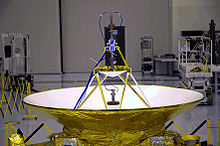
Communication with the spacecraft is via X band. The craft had a communication rate of 38 kbit/s at Jupiter; at Pluto's distance, a rate of approximately 1 kbit/s is expected. Besides the low bandwidth, Pluto's distance also causes a latency of about 4.5 hours (one-way). The 70 m (230 ft) Deep Space Network (DSN) dishes are used to relay commands once it is beyond Jupiter. The spacecraft uses dual redundant transmitters and receivers, and either right- or left-hand circular polarization. The downlink signal is amplified by dual redundant 12-watt traveling-wave tube amplifiers (TWTAs) mounted on the body under the dish. The receivers are new, low-power designs. The system can be controlled to power both TWTAs at the same time, and transmit a dual-polarized downlink signal to the DSN that nearly doubles the downlink rate. DSN tests early in the mission with this dual polarization combining technique were successful, and the capability is now considered operational (when the spacecraft power budget permits both TWTAs to be powered).
In addition to the high-gain antenna, there are two low-gain antennas and a medium-gain dish. The high-gain dish has a Cassegrain reflector layout, composite construction, and a 2.1-meter (7 ft) diameter providing over 42 dBi of gain, has a half-power beam width of about a degree. The prime-focus, medium-gain antenna, with a 0.3-meter (1 ft) aperture and 10° half-power beamwidth, is mounted to the back of the high-gain antenna's secondary reflector. The forward low-gain antenna is stacked atop the feed of the medium-gain antenna. The aft low-gain antenna is mounted within the launch adapter at the rear of the spacecraft. This antenna was used only for early mission phases near Earth, just after launch and for emergencies if the spacecraft had lost attitude control.
New Horizons will record scientific instrument data to its solid-state buffer at each encounter, then transmit the data to Earth. Data storage is done on two low-power solid-state recorders (one primary, one backup) holding up to 8 gigabytes each. Because of the extreme distance from Pluto and the Kuiper belt, only one buffer load at those encounters can be saved. This is because New Horizons will require 45 to 90 days after it has left the vicinity of Pluto (or future target object) to transmit the buffer load back to Earth.[44]
Part of the reason for the delay between the gathering of and transmission of data is because all of the New Horizons instrumentation is body-mounted. In order for the cameras to record data, the entire probe must turn, and the one-degree-wide beam of the high-gain antenna will almost certainly not be pointing toward Earth. Previous spacecraft, such as the Voyager program probes, had a rotatable instrumentation platform (a "scan platform") that could take measurements from virtually any angle without losing radio contact with Earth. New Horizons' elimination of excess mechanisms was implemented to save weight, shorten the schedule, and improve reliability during its 15-year lifetime.
The Voyager 2 spacecraft experienced platform jamming at Saturn; the demands of long time exposures at Uranus led to modifications of the mission such that the entire probe was rotated to make the time exposure photos at Uranus and Neptune, similar to how New Horizons will rotate.
Science payload
New Horizons carries seven instruments: three optical instruments, two plasma instruments, a dust sensor and a radio science receiver/radiometer. The instruments are to be used to investigate the global geology, surface composition and temperature, and the atmospheric pressure, temperature and escape rate of Pluto and its moons. The rated power is 21 watts, though not all instruments operate simultaneously.[45] In addition, New Horizons has an Ultrastable Oscillator subsystem, which may be used to study and test the Pioneer anomaly towards the end of the spacecraft's life.[46]
Long-Range Reconnaissance Imager (LORRI)
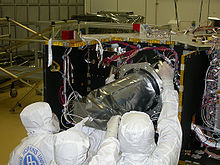
The Long-Range Reconnaissance Imager (LORRI) is a long-focal-length imager designed for high resolution and responsivity at visible wavelengths. The instrument is equipped with a high-resolution 1024×1024 monochromatic CCD imager with a 208.3 mm (8.20 in) aperture giving a resolution of 5 μrad (~1 arcsec). The CCD is chilled far below freezing by a passive radiator on the antisolar face of the spacecraft. This temperature differential requires insulation, and isolation from the rest of the structure. The Ritchey–Chretien mirrors and metering structure are made of silicon carbide, to boost stiffness, reduce weight, and prevent warping at low temperatures. The optical elements sit in a composite light shield, and mount with titanium and fibreglass for thermal isolation. Overall mass is 8.6 kg (19 lb), with the optical tube assembly (OTA) weighing about 5.6 kg (12 lb),[47] for one of the largest silicon-carbide telescopes flown at the time (now superseded by Herschel).
- Principal investigator: Andy Cheng, Applied Physics Laboratory, Data: LORRI image search at jhuapl.edu[48]
Solar Wind At Pluto (SWAP)
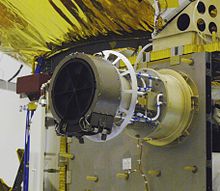
Solar Wind At Pluto (SWAP) is a toroidal electrostatic analyzer and retarding potential analyzer (RPA), that makes up one of the two instruments comprising New Horizons' Plasma and high-energy particle spectrometer suite (PAM), the other being PEPSSI. SWAP measures particles of up to 6.5 keV and, because of the tenuous solar wind at Pluto's distance, the instrument is designed with the largest aperture of any such instrument ever flown.
- Principal investigator: David McComas, Southwest Research Institute
Pluto Energetic Particle Spectrometer Science Investigation (PEPSSI)
Pluto Energetic Particle Spectrometer Science Investigation (PEPSSI) is a time of flight ion and electron sensor that makes up one of the two instruments comprising New Horizons' plasma and high-energy particle spectrometer suite (PAM), the other being SWAP. Unlike SWAP, which measures particles of up to 6.5 keV, PEPSSI goes up to 1 MeV.
- Principal investigator: Ralph McNutt Jr., Applied Physics Laboratory
Alice
Alice is an ultraviolet imaging spectrometer that is one of two photographic instruments comprising New Horizons' Pluto Exploration Remote Sensing Investigation (PERSI); the other being the Ralph telescope. It resolves 1,024 wavelength bands in the far and extreme ultraviolet (from 50–180 nm), over 32 view fields. Its goal is to determine the atmospheric composition of Pluto. This Alice instrument is derived from another Alice aboard the ESA's Rosetta spacecraft.
- Principal investigator: Alan Stern, Southwest Research Institute
Ralph telescope
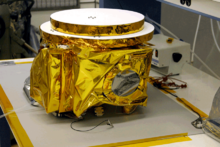
The Ralph telescope, 6 cm (2.4 in) in aperture, is one of two photographic instruments that make up New Horizons' Pluto Exploration Remote Sensing Investigation (PERSI), with the other being the Alice instrument. Ralph has two separate channels: a visible-light CCD imager (MVIC- Multispectral Visible Imaging Camera) with broadband and color channels, and a near-infrared imaging spectrometer, LEISA (Linear Etalon Imaging Spectral Array). LEISA is derived from a similar instrument on the EO-1 mission. Ralph was named after Alice's husband on The Honeymooners, and was designed after Alice.
- Principal investigator: Alan Stern, Southwest Research Institute
Student Dust Counter (SDC)
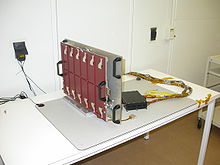
The Student Dust Counter (SDC), built by students at the University of Colorado Boulder, will operate continuously to make dust measurements. It consists of a detector panel, about 460 mm × 300 mm (18 in × 12 in), mounted on the anti-solar face of the spacecraft (the ram direction), and an electronics box within the spacecraft. The detector contains fourteen polyvinylidene difluoride (PVDF) panels, twelve science and two reference, which generate voltage when impacted. Effective collecting area is 0.125 m2 (1.35 sq ft). No dust counter has operated past the orbit of Uranus; models of dust in the outer Solar System, especially the Kuiper belt, are speculative. VBSDC is always turned on measuring the masses of the interplanetary and interstellar dust particles (in the range of nano- and picograms) as they collide with the PVDF panels mounted on the New Horizons spacecraft. The measured data is expected to greatly contribute to the understanding of the dust spectra of the Solar System. The dust spectra can then be compared with those from observations of other stars, giving new clues as to where Earth-like planets can be found in the universe. The dust counter is named for Venetia Burney, who first suggested the name "Pluto" at the age of 11. A thirteen-minute short film about VBSDC garnered an Emmy Award for student achievement in 2006.[49]
- Principal investigator: Mihaly Horanyi, University of Colorado Boulder
Radio Science Experiment (REX)
The Radio Science Experiment (REX) will use an ultrastable crystal oscillator (essentially a calibrated crystal in a miniature oven) and some additional electronics to conduct radio science investigations using the communications channels. These are small enough to fit on a single card. Because there are two redundant communications subsystems, there are two, identical REX circuit boards.
- Principal investigators: Len Tyler and Ivan Linscott, Stanford University
-
REX information, from a BOINC screensaver
-
BOINC screensaver, Charon Radio Science
-
REX information, link to PDF of Radio Science Proposal
Mission progress
Launch
On September 24, 2005 the spacecraft arrived at the Kennedy Space Center on board a C-17 Globemaster III for launch preparations.[50] The launch of New Horizons was originally scheduled for January 11, 2006, but was initially delayed until January 17, 2006 to allow for borescope inspections of the Atlas V's kerosene tank. Further delays related to low cloud ceiling conditions downrange, and high winds and technical difficulties—unrelated to the rocket itself—prevented launch for a further two days.[51][52] Although there were backup launch opportunities in February 2006 and February 2007, only the first twenty-three days of the 2006 window permitted the Jupiter flyby. Any launch outside that period would have forced the spacecraft to fly a slower trajectory directly to Pluto, delaying its encounter by 2–4 years. The probe finally lifted off from Pad 41 at Cape Canaveral Air Force Station, Florida, directly south of Space Shuttle Launch Complex 39, at 14:00 EST on January 19, 2006.[53][54]
The Centaur second stage reignited at 14:30 EST (19:30 UTC), followed by the ATK Star 48B third stage, successfully sending the probe on a solar-escape trajectory. New Horizons took only nine hours to reach the Moon's orbit, passing lunar orbit before midnight EST that day.
The probe was launched by a Lockheed Martin Atlas V 551 rocket, with a third stage added to increase the heliocentric (escape) speed. This was the first launch of the Atlas V 551 configuration, which uses five solid rocket boosters, and the first Atlas V with a third stage. Previous flights had used zero, two, or three solid boosters, but never five. The vehicle, AV-010, weighed 570,000 kg (1.26 million lb) at lift-off, and had earlier been slightly damaged when Hurricane Wilma swept across Florida on October 24, 2005. One of the solid rocket boosters was hit by a door. The booster was replaced with an identical unit, rather than inspecting and requalifying the original.[55]
New Horizons is often given the title of Fastest Spacecraft Ever Launched,[citation needed] and left Earth faster than any other spacecraft to date. It is also the first spacecraft launched directly into a solar escape trajectory, which requires an approximate speed of 16.5 km/s (59,000 km/h; 37,000 mph), plus aerodynamic and gravity losses[clarification needed], all to be provided by the launcher. But it is not the fastest spacecraft to leave the Solar System. This record is held by Voyager 1, currently travelling at 17.145 km/s (61,720 km/h; 38,350 mph) relative to the Sun. Voyager 1 attained greater hyperbolic excess velocity from Jupiter and Saturn gravitational slingshots than New Horizons. Other spacecraft, such as the Helios probes, can also be measured as the fastest objects, because of their orbital speed relative to the Sun at perihelion. Because they remain in solar orbit, their specific orbital energy relative to the Sun is lower than New Horizons and other artificial objects escaping the Solar System.
The Star 48B third-stage is also on a hyperbolic Solar System escape trajectory, and reached Jupiter before the New Horizons spacecraft. Because it is not in controlled flight, it did not receive the correct gravity assist, and will only pass within 200 million km (120 million mi) of Pluto.[56] The Centaur stage did not achieve solar escape velocity, and is in heliocentric orbit.[57] The launch was dedicated to the memory of launch conductor Daniel Sarokon, who was described by space program officials as one of the most influential people in the history of space travel.[58]
Inner Solar System
Trajectory corrections
On January 28 and 30, 2006, mission controllers guided the probe through its first trajectory-correction maneuver (TCM), which was divided into two parts (TCM-1A and TCM-1B). The total velocity change of these two corrections was about 18 meters per second (65 km/h; 40 mph). TCM-1 was accurate enough to permit the cancellation of TCM-2, the second of three originally scheduled corrections.[59] On March 9, 2006, controllers performed TCM-3, the last of three scheduled course corrections. The engines burned for 76 seconds, adjusting the spacecraft's velocity by about 1.16 m/s (4.2 km/h; 2.6 mph).[60] Further trajectory maneuvers were not needed until seven months after the Jupiter flyby in September 25, 2007, when the engines were fired for 15 minutes and 37 seconds, changing the spacecraft's velocity by 2.37 m/s (8.5 km/h; 5.3 mph),[61] followed by another TCM, almost three years later on June 30, 2010, that lasted 35.6 seconds, when New Horizons had already reached the halfway point (in time traveled) to Pluto.[62]
In-flight tests and Mars orbit
During the week of February 20, 2006, controllers conducted initial in-flight tests of three onboard science instruments, the Alice ultraviolet imaging spectrometer, the PEPSSI plasma-sensor, and the LORRI long-range visible-spectrum camera. No scientific measurements or images were taken, but instrument electronics, and in the case of Alice, some electromechanical systems were shown to be functioning correctly.[63] On April 7, 2006, the spacecraft passed the orbit of Mars, moving at roughly 21 km/s (76,000 km/h; 47,000 mph) away from the Sun at a solar distance of 243 million kilometers.[64][65][66]
Asteroid 132524 APL
Because of the need to conserve fuel for possible encounters with Kuiper belt objects subsequent to the Pluto flyby, intentional encounters with objects in the asteroid belt were not planned. After launch, the New Horizons team scanned the spacecraft's trajectory to determine if any asteroids would, by chance, be close enough for observation. In May 2006 it was discovered that New Horizons would pass close to the tiny asteroid 132524 APL on June 13, 2006. Closest approach occurred at 4:05 UTC at a distance of 101,867 km (63,297 mi). The asteroid was imaged by Ralph (use of LORRI was not possible because of proximity to Sun), which gave the team a chance to test Ralph's capabilities, and make observations of the asteroid's composition as well as light and phase curves. The asteroid was estimated to be 2.5 km (1.6 mi) in diameter.[67][68][69] The spacecraft successfully tracked the asteroid over June 10–12, 2006. This allowed the mission team to test the spacecraft's ability to track rapidly moving objects. Images were obtained through the Ralph telescope.[69]
First Pluto sighting
The first images of Pluto from New Horizons were acquired September 21–24, 2006, during a test of the LORRI. They were released on November 28, 2006.[70] The images, taken from a distance of approximately 4,200,000,000 km (2.6×109 mi) or 28.07 AU, confirmed the spacecraft's ability to track distant targets, critical for maneuvering toward Pluto and other Kuiper belt objects.
Jupiter encounter
New Horizons used LORRI to take its first photographs of Jupiter on September 4, 2006 from a distance of 291 million kilometers (181 million miles).[71] More detailed exploration of the system began in January 2007 with an infrared image of the moon Callisto, as well as several black-and-white images of Jupiter itself.[72] New Horizons received a gravity assist from Jupiter, with its closest approach at 05:43:40 UTC on February 28, 2007 when it was 2.3 million kilometers (1.4 million miles) from Jupiter. The flyby increased New Horizons' speed by 4 km/s (14,000 km/h; 9,000 mph), accelerating the probe to a velocity of 23 km/s (83,000 km/h; 51,000 mph) relative to the Sun and shortening its voyage to Pluto by three years.[73]
The flyby was the center of a 4-month intensive observation campaign lasting from January to June. Being an ever-changing scientific target, Jupiter has been observed intermittently since the end of the Galileo mission in September 2003. Knowledge about Jupiter benefited from the fact that New Horizons' instruments were built using the latest technology, especially in the area of cameras, representing a significant improvement over Galileo's cameras, which were modified versions of Voyager cameras, which, in turn, were modified Mariner cameras. The Jupiter encounter also served as a shakedown and dress rehearsal for the Pluto encounter. Because Jupiter is much closer to Earth than Pluto, the communications link can transmit multiple loadings of the memory buffer; thus the mission actually returned more data from the Jovian system than it is expected to transmit from Pluto.[74]
One of the main goals during the Jupiter encounter was observing its atmospheric conditions and analyzing the structure and composition of its clouds. Heat-induced lightning strikes in the polar regions and "waves" that indicate violent storm activity were observed and measured. The Little Red Spot, spanning up to 70% of Earth's diameter, was imaged from up close for the first time.[73]
Recording from different angles and illumination conditions, New Horizons took detailed images of Jupiter's faint ring system, discovering debris left over from recent collisions within the rings or from other unexplained phenomena. The search for undiscovered moons within the rings showed no results. Travelling through Jupiter's magnetosphere, New Horizons collected valuable particle readings.[73] "Bubbles" of plasma that are thought to be formed from material ejected by the moon Io, were noticed in the magnetotail.[75]

Jovian moons
The four largest moons of Jupiter were in poor positions for observation; the necessary path of the gravity-assist maneuver meant that New Horizons passed millions of kilometers from any of the Galilean moons. Still, its instruments were intended for small, dim targets, so they were scientifically useful on large, distant moons. Emphasis was put on Jupiter's innermost Galilean moon, Io, whose active volcanoes shoot out tons of material into Jupiter's magnetosphere, and further. Out of eleven observed eruptions, three were seen for the first time. That of Tvashtar reached an altitude of up to 330 kilometers. The event gave scientists an unprecedented look into the structure and motion of the rising plume and its subsequent fall back to the surface. Infrared signatures of a further 36 volcanoes were noticed.[73] Callisto's surface was analyzed with LEISA, revealing how lighting and viewing conditions affect infrared spectrum readings of its surface water ice.[76] Minor moons such as Amalthea had their orbit solutions refined. The cameras determined their positions, acting as "reverse optical navigation".
Outer Solar System
After passing Jupiter, New Horizons spent most of its journey towards Pluto in hibernation mode: redundant components as well as guidance and control systems were shut down to extend their life cycle, decrease operation costs and free the Deep Space Network for other missions.[77] During hibernation mode, the onboard computer monitored the probe's systems and transmitted a signal back to Earth: a "green" code if everything was functioning as expected or a "red" code if mission control's assistance was needed.[77] The probe was activated for about two months a year so that the instruments could be calibrated and the systems checked. The first hibernation mode cycle started on June 28, 2007,[77] the second cycle began on December 16, 2008,[78] the third cycle on August 27, 2009,[79] and the fourth cycle on August 29, 2014 after a 10-week test.[80]
New Horizons crossed the orbit of Saturn on June 8, 2008,[81] and Uranus on March 18, 2011.[82] After astronomers announced the discovery of two new moons in the Pluto system, Kerberos and Styx, mission planners started contemplating the possibility of the probe running into unseen debris and dust left over from earlier collisions with the moons. A study based on 18 months of computer simulations, Earth-based telescope observations and occultations of the Pluto system revealed that the possibility of a catastrophic collision with debris or dust is less than 0.3% on the probe's scheduled course.[83][84] If the hazard increases, New Horizons will use one of two possible contingency plans, the so-called SHBOTs (Safe Haven by Other Trajectories): the probe could continue on its present trajectory with the antenna facing the incoming particles so the more vital systems would be protected, or, it could position its antenna and make a course correction that would take it just 3000 km from the surface of Pluto where it is expected that the atmospheric drag would clean the surrounding space of possible debris.[84]
While in hibernation mode in July 2012, New Horizons started gathering scientific data with SWAP, PEPSSI and SDC. Although it was originally planned to activate just SDC, other instruments were powered on the initiative of principal investigator Alan Stern who decided they could use the opportunity to collect valuable heliospheric data. Before activating the other two instruments, ground tests were conducted to make sure that the expanded data gathering in this phase of the mission would not limit available energy, memory and fuel in the future and that all systems are functioning during the flyby.[85] The first set of data was transmitted in January 2013 during a three-week activation from hibernation. A new command and data handling software was also uploaded to address the problem of computer resets.[86]
Possible Neptune trojan targets
Other possible targets were Neptune trojans. The probe's trajectory to Pluto passed near Neptune's trailing Lagrange point ("L5"), which may host hundreds of bodies in 1:1 resonance. In late 2013, New Horizons passed within 1.2 AU (180,000,000 km; 110,000,000 mi) of the high-inclination L5 Neptune trojan 2011 HM102,[87] which was identified shortly before by the New Horizons KBO Search Survey team while searching for more distant objects for New Horizons to fly by after its 2015 Pluto encounter. At that range, 2011 HM102 would have been bright enough to be detectable by New Horizons' LORRI instrument; however, the New Horizons team eventually decided that they would not target 2011 HM102 for observations because the preparations for the Pluto approach took precedence.[88]
Observations of Pluto and Charon 2013–14
Images from July 1 to 3, 2013 by LORRI were the first by the probe to resolve Pluto and Charon as separate objects.[89] On July 14, 2014, mission controllers performed a sixth trajectory-correction maneuver (TCM) since its launch to enable the craft to reach Pluto.[90] Between July 19–24, 2014, New Horizons' LORRI snapped 12 images of Charon revolving around Pluto, covering almost one full rotation at distances ranging from about 429,000,000 km (267,000,000 mi) to 422,000,000 km (262,000,000 mi).[91] In August 2014, astronomers made high-precision measurements of Pluto's location and orbit around the Sun using the Atacama Large Millimeter/submillimeter Array (ALMA) to help NASA's New Horizons spacecraft accurately home in on Pluto.[92] On December 6, 2014, mission controllers sent a signal for the craft to "wake up" from its final Pluto-approach hibernation and begin regular operations. The craft's response that it was "awake" arrived to Earth at 9:30 PM EST.[93][94][95]
Pluto approach
Distant-encounter operations at Pluto began on January 4, 2015.[96] At this date images of the targets with the onboard LORRI imager plus Ralph telescope would only be a few pixels in width. Investigators have begun taking Pluto and background starfield images to assist mission navigators in the design of course-correcting engine maneuvers that precisely modify the trajectory of New Horizons to aim the approach.

On January 15, 2015, NASA gave a brief update of the timeline of the approach and departure phases.[97]
On February 12, 2015, NASA released new images of Pluto (taken from January 25 to 31) from the approaching probe.[98][99] New Horizons was more than 203,000,000 km (126,000,000 mi) away from Pluto when it began taking the photos, which showed Pluto and its largest moon, Charon. The exposure time was too short to see Pluto's smaller, much fainter, moons. Investigators compiled a series of images of the moons Nix and Hydra taken from January 27 through February 8, 2015, beginning at a range of 201,000,000 km (125,000,000 mi).[100] Pluto and Charon appear as a single overexposed object at the center. The right side image has been processed to remove the background starfield. The yet smaller two moons, Kerberos and Styx were seen on photos taken on April 25.[101] Starting May 11 a hazard search is performed, by looking for until then unknown objects that could be a danger to the spacecraft, such as rings or more moons, which are possible to avoid by a course change.[102]
Also in regards to this approach phase during January 2015, on August 21, 2012, the team had announced that they would also spend mission time attempting long-range observations of the Kuiper belt object, temporarily designated VNH0004, when the object was at a distance from New Horizons of 75 gigameters (0.50 AU).[103] The object would be too distant to resolve surface features or take spectroscopy, but it would be able to make observations that cannot be made from Earth, namely a phase curve and a search for small moons. A second object was planned to be observed in June 2015, and a third in September, after the flyby; the team hoped to observe a dozen such objects through 2018.[103] On April 15, 2015, Pluto was imaged showing a possible polar cap.[104]
Software glitch
On July 4, 2015, New Horizons experienced a software anomaly and went into safe mode, preventing the spacecraft from performing scientific observations until engineers could resolve the problem.[105][106] On July 5, NASA announced that the problem was determined to be a timing flaw in a command sequence used to prepare the spacecraft for its flyby, and the spacecraft would resume scheduled science operations on July 7. The science observations lost because of the anomaly were judged to have no impact on the mission's main objectives and minimal impact on other objectives.[107]
Pluto system encounter
The New Horizons spacecraft flew closest to Charon on July 14, 2015 12:03:50 UTC (08:03:50 EDT). The first details of the encounter are expected to be received later in the day, but download of the complete data will take much longer, and analysis of the data is expected to take up to three years.
Objectives
The mission's science objectives are grouped in three distinct priorities. The "primary objectives" are required by NASA and a loss of any of these objectives will constitute a partial failure of the mission, while it is expected, but not demanded, that most of the "secondary objectives" will be met. The "tertiary objectives" are desired. These objectives may be attempted, though they may be skipped in favor of the above objectives. An objective to measure any magnetic field of Pluto was dropped. A magnetometer instrument could not be implemented within a reasonable mass budget and schedule, and SWAP and PEPSSI could do an indirect job detecting some magnetic field around Pluto.[citation needed]
- Primary objectives (required)
- Characterize the global geology and morphology of Pluto and Charon
- Map chemical compositions of Pluto and Charon surfaces
- Characterize the neutral (non-ionized) atmosphere of Pluto and its escape rate
- Secondary objectives (expected)
- Characterize the time variability of Pluto's surface and atmosphere
- Image select Pluto and Charon areas in stereo
- Map the terminators (day/night border) of Pluto and Charon with high resolution
- Map the chemical compositions of select Pluto and Charon areas with high resolution
- Characterize Pluto's ionosphere (upper layer of the atmosphere) and its interaction with the solar wind
- Search for neutral species such as H2, hydrocarbons, HCN and other nitriles in the atmosphere
- Search for any Charon atmosphere
- Determine bolometric Bond albedos for Pluto and Charon
- Map surface temperatures of Pluto and Charon
- Map any additional surfaces of outermost moons: Nix, Hydra, Kerberos, and Styx
- Tertiary objectives (desired)
The close encounter

New Horizons was intended to pass within 12,500 km (7,800 mi) of Pluto, with this closest approach on July 14, 2015 at 11:50 UTC. New Horizons will have a relative velocity of 13.78 km/s (49,600 km/h; 30,800 mph) at its closest approach, and came as close as 28,800 km (17,900 mi) to Charon, although these parameters may be changed during flight. Starting 3.2 days before the closest approach, long-range imaging included the mapping of Pluto and Charon to 40 km (25 mi) resolution. This is half the rotation period of the Pluto–Charon system and allowed imaging of all sides of both bodies. Coverage will repeat twice per day, to search for changes due to snows or cryovolcanism. Because of Pluto's tilt, a portion of the northern hemisphere will be in shadow at all times. During the flyby, LORRI should be able to obtain select images with resolution as high as 50 m/px (if closest distance is around 12,500 km), and MVIC should obtain four-color global dayside maps at 1.6 km resolution. LORRI and MVIC will attempt to overlap their respective coverage areas to form stereo pairs. LEISA will obtain hyperspectral near-infrared maps at 7 km/px globally and 0.6 km/px for selected areas.
Meanwhile, Alice will characterize the atmosphere, both by emissions of atmospheric molecules (airglow), and by dimming of background stars as they pass behind Pluto (occultation). During and after closest approach, SWAP and PEPSSI will sample the high atmosphere and its effects on the solar wind. VBSDC will search for dust, inferring meteoroid collision rates and any invisible rings. REX will perform active and passive radio science. Ground stations on Earth will transmit a powerful radio signal as New Horizons passes behind Pluto's disk, then emerges on the other side. The communications dish will measure the disappearance and reappearance of the radio occultation signal. The results will resolve Pluto's diameter (by their timing) and atmospheric density and composition (by their weakening and strengthening pattern). (Alice can perform similar occultations, using sunlight instead of radio beacons.) Previous missions had the spacecraft transmit through the atmosphere, to Earth ("downlink"). Low power and extreme distance means New Horizons will be the first such "uplink" mission. Pluto's mass and mass distribution will be evaluated by their tug on the spacecraft. As the spacecraft speeds up and slows down, the radio signal will experience a Doppler shift. The Doppler shift will be measured by comparison with the ultrastable oscillator in the communications electronics.
Reflected sunlight from Charon will allow some imaging observations of the nightside. Backlighting by the Sun will highlight any rings or atmospheric hazes. REX will perform radiometry of the nightside.
Lesser satellite observations
New Horizons' best spatial resolution of the small satellites is 460m/pixel at Nix, 1.1 km/pixel at Hydra, 3.2 km/pixel at Kerberos, and 3.2 km/pixel at Styx. Estimates for the diameters of these bodies are: Nix, 56 × 26 km; Hydra, 58 × 34 km; Kerberos, 31 km; and Styx, 8 to 28 km. This translates to a resolution of 120, 50, 10, and 2 to 10 pixels in width for Nix, Hydra, Kerberos, and Styx, respectively.
Current status

The New Horizons spacecraft flew closest to Charon on July 14, 2015 12:03:50 UTC (08:03:50 EDT).[1]
- The spacecraft currently travels at 14.52 km/s (9.02 mi/s; 3.06 AU/a; 0.00839 AU/d) relative to the Sun and at 13.78 km/s (8.56 mi/s; 2.91 AU/a; 0.00796 AU/d) relative to Pluto.
- Radio signals take four and a half hours to travel between the spacecraft and Earth.[108]
- The brightness of the Sun from the spacecraft is magnitude −19.2.[109]
- New Horizons is heading in the direction of the constellation Sagittarius.[109]
- The latest news and photos from the probe are posted on NASA's mission website.[1]
Future mission objectives
Kuiper belt object (KBO) mission
Target background
After passing Pluto, New Horizons will continue on to the Kuiper belt. The goal is to study one or two other Kuiper belt objects (KBOs). Because maneuvering capability is limited, this phase of the mission is contingent on the presence of suitable KBOs close to New Horizons' flight path. This ruled out any possibility for a flyby of Eris, a trans-Neptunian object comparable in size to Pluto.[111] Because the flight path is determined by the Pluto flyby, with only minimal hydrazine remaining, objects need to be found within a cone, extending from Pluto, of less than a degree's width, and within 55 AU. Beyond 55 AU, the communications link will become too weak, and the RTG wattage will have decayed significantly enough to hinder observations. Desirable KBOs should be well over 50 km (31 mi) in diameter, neutral in color (to compare with the reddish Pluto), and, if possible, have a moon that imparts a wobble. Because the population of KBOs appears quite large, multiple objects may qualify. Mission planners searched for one or more additional Kuiper belt objects (KBOs) of the order of 50–100 km (31–62 mi) in diameter as targets for flybys similar to the spacecraft's Plutonian encounter. The available region, being fairly close to the plane of the Milky Way and hence difficult to survey for dim objects, is one that was not well-covered by previous KBO search efforts.
Search
In 2011 a dedicated search for suitable KBOs using ground telescopes was started. Large ground telescopes with wide-field cameras, notably the twin 6.5-meter Magellan Telescopes in Chile, the 8.2-meter Subaru Observatory in Hawaii, and the Canada–France–Hawaii Telescope[87][112] were used to search for potential targets. Through the citizen science project, the public helped to scan telescopic images for possible suitable mission candidates by participating in the Ice Hunters project.[113][114][115][116][117] The ground-based search resulted in the discovery of about 143 KBOs of potential interest,[118] but none of these were close enough to the flight path of New Horizons.[112] Only the Hubble Space Telescope was deemed likely to find a suitable target in time for a successful KBO mission.[119] On June 16, 2014, time on Hubble was granted.[120] Hubble has a much greater ability to find suitable KBOs than ground telescopes. The probability that a target for New Horizons would be found was estimated beforehand at about 95%.[121]
Suitable KBOs
On October 15, 2014, it was revealed that Hubble's search had uncovered three potential targets,[110][122][123][124][125] provisionally designated PT1 ("potential target 1"), PT2 and PT3 by the New Horizons team. All are objects with estimated diameters in the 30–55 km range, too small to be seen by ground telescopes, at distances from the Sun of 43–44 AU, which would put the encounters in the 2018–2019 period.[122] The initial estimated probabilities that these objects are reachable within New Horizons' fuel budget are 100%, 7%, and 97%, respectively.[122] All are members of the "cold" (low-inclination, low-eccentricity) classical Kuiper belt, and thus very different from Pluto. PT1 (designated 1110113Y on the HST web site[126]), the most favorably situated object, is magnitude 26.8, 30–45 km in diameter, and would be encountered around January 2019.[127] A course to reach it would require about 35% of New Horizons' available trajectory-adjustment fuel supply. A mission to PT3 may be preferable, because it is brighter and therefore probably larger than PT1.[122]
The potential target KBOs were initially given the labels PT1 , PT2, and PT3. Once sufficient orbital information was provided, the Minor Planet Center gave them their official designations: 2014 MU69 (PT1), 2014 OS393 (PT2), and 2014 PN70 (PT3). (By the fall of 2014, a possible fourth target, 2014 MT69 had been eliminated by follow-up observations.) The preferred flyby target is PT1, a 40–70 km object, but PT3, a slightly bigger object, could also be targeted for a flyby, with the decision to be made in August. PT2 is no longer under consideration.[128]
Post-KBO mission
Provided it survives, New Horizons is likely to follow the Voyager probes in exploring the outer heliosphere and mapping the heliosheath and heliopause. The heliopause might be reached around 2047.[129]
Even though it was launched far faster than any outward probe before it, New Horizons will never overtake either Voyager 1 or Voyager 2 as the most distant human-made object from Earth. Close fly-bys of Saturn and Titan gave Voyager 1 an advantage with their gravity assist. When New Horizons reaches the distance of 100 AU, it will be travelling at about 13 km/s (29,000 mph), around 4 km/s (8,900 mph) slower than Voyager 1 at that distance.[130]
Public-defined TNO mission
In August 2013, it was proposed[131] to use the radio-tracking data from New Horizons to discover constraints on the position of a hypothesized trans-Neptunian planetary-sized body.[132]
Gallery
Images of the launch
-
The Atlas V 551 rocket, used to launch New Horizons, being processed a month before launch.
-
View of Cape Canaveral Launch Complex 41, with the Atlas V carrying New Horizons on the pad.
-
Distant view of Cape Canaveral during the launch of New Horizons on January 19, 2006.
-
NASA TV footage of New Horizons' launch from Cape Canaveral. (4:00)
Images of Jupiter flyby
-
LORRI images of Jupiter's rings. The top image was taken on approach to Jupiter, whereas the bottom image was taken on departure, illuminated by the Sun.
-
A composite false-color image of Oval BA, otherwise known as the "Little Red Spot", using New Horizons' LORRI and the Hubble Space Telescope's WFPC2.
-
An MVIC image of Jupiter's equatorial atmosphere, showing Buoyancy waves that travel at 100m/s faster than surrounding clouds.
Images of Jupiter's moons
-
A LORRI image of Io, taken while New Horizons passed through its penumbra. Volcanic plumes, lava and aurora are all visible in this image.
-
New Horizons view of Europa. One of the goals of New Horizons at Europa was to examine the "nature of the icy crust and the forces that have deformed it".
-
New Horizons' view of Ganymede
Images of Pluto during approach phase
-
May 2015: Pluto as seen by LORRI during AP2 from a distance of 75 million km away[134]
-
May 2015: Rotating Pluto as seen from about 50–55 million km away
-
June 2015: Pluto's closest-approach hemisphere seen from 31 million km away
-
June 2015: Pluto image (color) from 18 million km away
-
June 2015: Pluto system, taken by the New Horizons space probe.
-
June 2015: Pluto (left) and its moon Charon, taken by the New Horizons space probe.
-
June 2015: Pluto - two faces - away from Charon (left); toward Charon (right).
-
June 2015: Pluto - two different sides - in color.
Timeline
| Phase | Date | Event | Description | References |
|---|---|---|---|---|
| Pre-Launch Phase | January 8, 2001 | Proposal team meets face-to-face for the first time at the Johns Hopkins University Applied Physics Laboratory | [135] | |
| February 5, 2001 | New Horizons name chosen. | [135][136] | ||
| April 6, 2001 | New Horizons proposal submitted to NASA. | It was one of five proposals submitted, which were later narrowed to two for Phase A study: POSSE (Pluto and Outer Solar System Explorer) and New Horizons. | [135] | |
| November 29, 2001 | New Horizons proposal selected by NASA. | Started Phase B study. | [137] | |
| March 2002 | Budget zeroed by Bush administration, later overridden | [138] | ||
| June 13, 2005 | Spacecraft departed Applied Physics Laboratory for final testing. | Spacecraft undergoes final testing at Goddard Space Flight Center (GSFC). | [140] | |
| September 24, 2005 | Spacecraft shipped to Cape Canaveral | It was moved through Andrews Air Force Base aboard a C-17 Globemaster III cargo aircraft. | [50] | |
| December 17, 2005 | Spacecraft ready for in rocket positioning | Transported from Hazardous Servicing Facility to Vertical Integration Facility at Space Launch Complex 41. | [citation needed] | |
| January 11, 2006 | Primary launch window opened | The launch was delayed for further testing. | [citation needed] | |
| January 16, 2006 | Rocket moved onto launch pad | Atlas V launcher, serial number AV-010, rolled out onto pad. | [141] | |
| January 17, 2006 | Launch delayed | First day launch attempts scrubbed because of unacceptable weather conditions (high winds). | [51][52] | |
| January 18, 2006 | Launch delayed again | Second launch attempt scrubbed because of morning power outage at the Applied Physics Laboratory. | [142] | |
| Launch Phase | January 19, 2006 | Successful launch at 14:00 EST (19:00 UTC) | The spacecraft was successfully launched after brief delay due to cloud cover. | [53][54] |
| Fly-by Phase | April 7, 2006 | Passes Mars | The probe passed Mars: 1.7 AU from Earth. | [64][143] |
| June 13, 2006 | Flyby of asteroid 132524 APL | The probe passed closest to the asteroid 132524 APL in the Belt at about 101,867 km at 04:05 UTC. Pictures were taken. | [144] | |
| November 28, 2006 | First image of Pluto | The image of Pluto was taken from a great distance. | [70] | |
| January 10, 2007 | Navigation exercise near Jupiter | Long-distance observations of Jupiter's outer moon Callirrhoe as a navigation exercise. | [145] | |
| February 28, 2007 | Jupiter flyby | Closest approach occurred at 05:43:40 UTC at 2.305 million km, 21.219 km/s. | [146] | |
| June 8, 2008 | Passing of Saturn's orbit | The probe passed Saturn's orbit: 9.5 AU from Earth. | [146][147] | |
| December 29, 2009 | The probe became closer to Pluto than to Earth | Pluto was then 32.7 AU from Earth, and the probe was 16.4 AU from Earth | [148][149][150] | |
| February 25, 2010 | Half mission distance reached | Half the travel distance of 2.38×109 kilometers (1,480,000,000 mi) was completed. | [151] | |
| March 18, 2011 | The probe passed Uranus's orbit | This is the fourth planetary orbit the spacecraft crossed since its start. New Horizons reached Uranus's orbit at 22:00 GMT. | [152][153] | |
| December 2, 2011 | New Horizons drew closer to Pluto than any other spacecraft has ever been. | Previously, Voyager 1 held the record for the closest approach. (~10.58 AU) | [154] | |
| February 11, 2012 | New Horizons was 10 AU from Pluto. | Distance from Pluto at around 4:55 UTC. | [155] | |
| July 1, 2013 | New Horizons captures its first image of Charon | Charon is clearly separated from Pluto using the Long-Range Reconnaissance Imager (LORRI). | [156][157] | |
| October 25, 2013 | New Horizons was 5 AU from Pluto. | Distance from Pluto | [155][158] | |
| July 20, 2014 | Photos of Pluto and Charon | Images obtained showing both bodies orbiting each other, distance 2.8 AU. | [159] | |
| August 25, 2014 | The probe passed Neptune's orbit | This was the fifth planetary orbit crossed. | [160] | |
| December 7, 2014 | New Horizons awoke from hibernation. | NASA's Deep Sky Network station at Tidbinbilla, Australia received a signal confirming that it successfully awoke from hibernation. | [93][94] | |
| January 2015 | Observation of Kuiper belt object 2011 KW48 | Distant observations from a distance of roughly 75 million km (~0.5 AU) | [161] | |
| January 15, 2015 | New Horizons is now close enough to Pluto and begins observing the system | Distance from Pluto | [162][163] | |
| March 10–11, 2015 | New Horizons was 1 AU from Pluto. | Distance from Pluto | [164] | |
| March 20, 2015 | NASA invitation | NASA invited general public to suggest names to surface features that will be discovered on Pluto and Charon | [165] | |
| May 15, 2015 | Better than Hubble | Images exceed best Hubble Space Telescope resolution. | [166] | |
| Science Phase | July 14, 2015 | Flyby of Pluto, Charon, Hydra, Nix, Kerberos and Styx | • Flyby of Pluto around 11:49:57 UTC at 12,500 km, 13.78 km/s. • Pluto is 32.9 AU from Sun. • Flyby of Charon around 12:03:50 UTC at 28,858 km, 13.87 km/s. |
[167] |
| 2016–20 | Possible flyby of one or more Kuiper belt objects (KBOs) | The probe will perform flybys of other KBOs, if any are in the spacecraft's trajectory. Heliosphere data collection expected to begin. | [168] | |
| January 2019 | Possible flyby of 2014 MU69 | 2014 MU69 (also labeled "PT1" [169]) is currently the most probable known target in the Kuiper belt. Heliosphere data collection expected to continue. | [170][171] | |
| 2026 | Expected end of the mission, based on RTG plutonium decay. | Heliosphere data collection expected to be intermittent if instrument power sharing is required. | [172] | |
| Post-Mission Phase | 2038 | New Horizons will be 100 AU from the Sun. | If still functioning, the probe will explore the outer heliosphere. | [130] |
See also
- List of artificial objects escaping from the Solar System
- List of spaceflights (2006)
- New Horizons 2—a proposed, but scrapped, twin of New Horizons
- Pioneer 10
- Pioneer 11
- Robotic spacecraft
- Space exploration
- Timeline of Solar System exploration
References
- ^ a b c d "New Horizons to Pluto, Mission Website". US National Aeronautics and Space Administration (NASA). July 2, 2015. Retrieved July 7, 2015.
- ^ Chang, Kenneth (July 13, 2015). "A Close-Up for Pluto After Spacecraft's 3-Billion-MileTrip". New York Times. Retrieved July 13, 2015.
- ^ Chang, Kenneth (July 6, 2015). "Almost Time for Pluto's Close-Up". New York Times. Retrieved July 6, 2015.
- ^ a b Overbye, Dennis (July 6, 2015). "Reaching Pluto, and the End of an Era of Planetary Exploration". New York Times. Retrieved July 7, 2015. Cite error: The named reference "NYT-20150706-db" was defined multiple times with different content (see the help page).
- ^ "New Horizons: NASA's Mission to Pluto". NASA. Retrieved April 15, 2015.
- ^ "New Horizons - News". John's Hopkins Applied Physics Laboratory. December 6, 2014. Retrieved April 15, 2015.
- ^ Dunn, Marcia (July 14, 2015). "Pluto close-up: Spacecraft makes flyby of icy, mystery world". AP News. Retrieved July 14, 2015.
- ^ Betz, Eric (June 23, 2015). "Why didn't Voyager visit Pluto?". Astronomy. Kalmbach Publishing. Retrieved July 8, 2015.
- ^ Landau, Elizabeth R.; Medina, Enrique; Angrum, Andrea. "Frequently Asked Questions". Voyager. Jet Propulsion Laboratory (JPL) / National Aeronautics and Space Administration (NASA). Retrieved July 8, 2015. "Voyager 1 could have been aimed on to Pluto, but exploration of Titan and the rings of Saturn was a primary scientific objective. This caused the trajectory to be diverted upward out of the ecliptic plane such that no further planetary encounters were possible for Voyager 1."
- ^ a b c d e f g h Stern, Alan; Christopher, Russell (2009). New Horizons: Reconnaissance of the Pluto-Charon System and the Kuiper Belt. Springer Publishing. pp. 6, 7. ISBN 978-0-387-89518-5. Retrieved July 8, 2015.
- ^ Betz, Eric (June 24, 2015). "How'd we get New Horizons? You can thank the Pluto Underground". Astronomy. Kalmbach Publishing. Retrieved July 8, 2015.
- ^ a b c d e f g Davis, Jason (July 7, 2015). "Pushing Back the Frontier: How The Planetary Society Helped Send a Spacecraft to Pluto". The Planetary Society. Retrieved July 8, 2015.
- ^ a b Foust, Jeff (January 23, 2006). "A Journey's Ending and Beginning". The Space Review. SpaceNews. Retrieved July 8, 2015.
- ^ Betz, Eric (June 26, 2015). "Postage for Pluto: A 29-cent stamp pissed off scientists so much they tacked it to New Horizons". Astronomy. Kalmbach Publishing. Retrieved July 8, 2015.
- ^ "'Not Yet Explored' no more: New Horizons flying Pluto stamp to dwarf planet". collectSPACE. Robert Pearlman. July 7, 2015. Retrieved July 8, 2015.
- ^ Staehle, Robert L.; Terrile, Richard J.; Weinstein, Stacy S. (October 1, 1994). "To Pluto by way of a postage stamp". The Planetary Report. 14 (5): 4–11. Retrieved July 8, 2015.
- ^ a b c d e Hand, Eric (June 25, 2015). "Feature: How Alan Stern's tenacity, drive, and command got a NASA spacecraft to Pluto". Science. American Association for the Advancement of Science. Retrieved July 8, 2015.
- ^ a b Savage, Donald (June 6, 2001). "NASA Selects Two Investigations for Pluto-Kuiper Belt Mission Feasibility Studies". National Aeronautics and Space Administration (NASA). Archived from the original on July 9, 2015. Retrieved July 9, 2015.
{{cite news}}: Unknown parameter|deadurl=ignored (|url-status=suggested) (help) - ^ Savage, Donald (February 14, 2001). "NEAR Shoemaker's Historic Landing on Eros Exceeds Science, Engineering Expectations". National Aeronautics and Space Administration (NASA). Retrieved July 8, 2015.
- ^ Savage, Donald (November 29, 2001). "NASA Selects Pluto-Kuiper Belt Mission Phase B Study". National Aeronautics and Space Administration (NASA). Archived from the original on July 9, 2015. Retrieved July 9, 2015.
{{cite news}}: Unknown parameter|deadurl=ignored (|url-status=suggested) (help) - ^ "Departments of Space Studies & Space Operations" (PDF). Southwest Research Institute Planetary Science Directorate website. Southwest Research Institute. Retrieved March 14, 2010.
- ^ "Unabashedly Onward to the Ninth Planet". New Horizons website. Johns Hopkins/APL. Archived from the original on March 9, 2011. Retrieved October 25, 2008.
{{cite web}}: Unknown parameter|deadurl=ignored (|url-status=suggested) (help) - ^ "Pluto's Two Small Moons Christened Nix and Hydra". New Horizons website (Press release). Johns Hopkins APL. Retrieved October 25, 2008. Template:WebCite
- ^ "Send Your Name to Pluto". New Horizons website. Johns Hopkins APL. Archived from the original on March 9, 2011. Retrieved January 30, 2009.
{{cite web}}: Unknown parameter|deadurl=ignored (|url-status=suggested) (help) - ^ "Pluto Mission to Carry Piece of SpaceShipOne". Space.com. December 20, 2005. Archived from the original on March 9, 2011.
{{cite news}}: Unknown parameter|deadurl=ignored (|url-status=suggested) (help) - ^ "To Pluto, With Postage". collectSPACE. October 28, 2008. Archived from the original on March 9, 2011.
{{cite news}}: Unknown parameter|deadurl=ignored (|url-status=suggested) (help) - ^ "New Horizons launches on voyage to Pluto and beyond". spaceFlightNow. January 19, 2006. Archived from the original on March 9, 2011. Retrieved December 1, 2010.
{{cite news}}: Unknown parameter|deadurl=ignored (|url-status=suggested) (help) - ^ "To Pluto, with postage: Nine mementos fly with NASA's first mission to the last planet". collectSPACE. Retrieved October 29, 2013.
- ^ "NASA - A 'State' of Exploration". Nasa.gov. March 8, 2006. Retrieved October 29, 2013.
- ^ "The Everest of Planetary Exploration: New Horizons Explores The Pluto System 2015" (PowerPoint Presentation). NASA. Retrieved April 15, 2015.
- ^ "Solar System Exploration - New Horizons". NASA. February 27, 2015. Retrieved April 15, 2015.
- ^ New Horizons: Pluto map shows 'whale' of a feature by Jonathan Amos, on 8 July 2015 (BBC - Science & Environment section)
- ^ "New Horizons Spacecraft and Instruments". NASA. November 10, 2014. Retrieved April 15, 2015.
- ^ "New Frontiers Program: New Horizons Science Objectives". NASA - New Frontiers Program. Retrieved April 15, 2015.
- ^ Moore, Patrick (2010). The Sky at Night. Springer. p. 35. ISBN 978-1-4419-6408-3.
- ^ Attention: This template ({{cite doi}}) is deprecated. To cite the publication identified by doi:10.1007/s11214-008-9374-8, please use {{cite journal}} (if it was published in a bona fide academic journal, otherwise {{cite report}} with
|doi=10.1007/s11214-008-9374-8instead. - ^ Friederich, Steven (December 16, 2003). "Argonne Lab is developing battery for NASA missions". Idaho State Journal. Archived from the original on March 9, 2011.
{{cite news}}: Unknown parameter|deadurl=ignored (|url-status=suggested) (help) - ^ Pluto Probe Launch Scrubbed for Tuesday January 18, 2006 Template:WebCite
- ^ "Draft Environmental Impact Statement for the New Horizons Mission" (pdf). Johns Hopkins APL. Retrieved May 16, 2014.
- ^ "The PI's Perspective: Trip Report". NASA/Johns Hopkins University/APL/New Horizons Mission. March 27, 2007. Archived from the original on March 9, 2011. Retrieved August 5, 2009.
{{cite web}}: Unknown parameter|deadurl=ignored (|url-status=suggested) (help) - ^ NASA Briefly Lost Touch With Historic Pluto Mission. YouTube. July 6, 2015. Retrieved July 13, 2015.
- ^ Los Angeles Times (July 6, 2015). "Computer glitch doesn't stop New Horizons: Pluto encounter almost a week away". latimes.com. Retrieved July 13, 2015.
- ^ "Pluto Probe Suffers Glitch 10 Days Before Epic Flyby". Space.com. Retrieved July 13, 2015.
- ^ "NASA's New Horizons Nears Historic Encounter with Pluto". The Johns Hopkins University Applied Physics Laboratory LLC. April 14, 2015. Retrieved June 27, 2015.
- ^ Y. Guo; R. W. Farquhar (2006). "Baseline design of New Horizons mission to Pluto and the Kuiper belt". Acta Astronautica. 58 (10): 550–559. doi:10.1016/j.actaastro.2006.01.012.
- ^ M.M. Nieto (2008). "New Horizons and the onset of the Pioneer anomaly". Physics Letters B. 659 (3): 483–485. arXiv:0710.5135. Bibcode:2008PhLB..659..483N. doi:10.1016/j.physletb.2007.11.067.
- ^ A. F. Cheng; et al. "Long-Range Reconnaissance Imager on New Horizons" (PDF).
- ^ "New Horizons SCIENCE PHOTOS, search". http://pluto.jhuapl.edu/. Retrieved May 2, 2015.
{{cite web}}: External link in|website= - ^ YouTube – Destination: Pluto and Beyond Template:WebCite
- ^ a b "NASA'S Pluto Space Probe Begins Launch Preparations". SpaceDaily. September 27, 2005. Archived from the original on March 9, 2011. Retrieved January 12, 2011.
{{cite web}}: Unknown parameter|deadurl=ignored (|url-status=suggested) (help) - ^ a b "Winds Delay Launching for NASA Mission to Pluto". New York Times. January 17, 2006.
- ^ a b "Launch of NASA's Pluto Probe Delayed for 24 Hours". Space.com. January 17, 2006. Retrieved June 3, 2013.
- ^ a b Amir, A. (January 19, 2006). "Planetary News: New Horizons (2006) New Horizons launched on its way to Pluto". The Planetary Society. Retrieved March 14, 2011. archived at WebCite
- ^ a b Harwood, W. (January 19, 2006). "New Horizons launches on voyage to Pluto and beyond". Spaceflight Now Inc. Retrieved January 12, 2011.archived at WebCite
- ^ "Damage prompts booster replacement for Pluto probe". spaceFlightNow. Archived from the original on March 9, 2011. Retrieved July 31, 2007.
- ^ Tariq Malik. "Derelict Booster to Beat Pluto Probe to Jupiter". Space.com. Archived from the original on March 9, 2011. Retrieved September 22, 2006.
{{cite news}}: Unknown parameter|deadurl=ignored (|url-status=suggested) (help) - ^ "Where Is the New Horizons Centaur Stage?". Johns Hopkins APL.
- ^ "Spacecraft will carry memory of Sagamore native". TribLIVE. Retrieved June 3, 2013.
- ^ Stern, Alan (January 31, 2006). "Our Aim Is True". The PI's Perspective. Johns Hopkins APL. Archived from the original on March 9, 2011. Retrieved June 11, 2006.
{{cite web}}: Unknown parameter|deadurl=ignored (|url-status=suggested) (help) - ^ "New Horizons Adjusts Course Towards Jupiter". Johns Hopkins APL. March 9, 2006. Retrieved May 29, 2011.Template:WebCite
- ^ Buckley, M. (September 27, 2007). "Maneuver Puts New Horizons on a Straight Path to Pluto". Johns Hopkins APL. Retrieved March 1, 2011.Template:WebCite
- ^ "Course Correction Keeps New Horizons on Path to Pluto". Johns Hopkins APL. July 1, 2010. Retrieved March 17, 2014.
{{cite web}}: Unknown parameter|deadurl=ignored (|url-status=suggested) (help)Template:WebCite - ^ Stern, Alan (February 27, 2006). "Boulder and Baltimore". The PI's Perspective. Johns Hopkins APL. Archived from the original on March 9, 2011. Retrieved June 11, 2006.
{{cite web}}: Unknown parameter|deadurl=ignored (|url-status=suggested) (help) - ^ a b Malik, T. (April 7, 2006). "Pluto-Bound Probe Passes Mars' Orbit". Space.com. Archived from the original on March 9, 2011. Retrieved January 14, 2011.
{{cite web}}: Unknown parameter|deadurl=ignored (|url-status=suggested) (help) - ^ "Outbound for the Frontier, New Horizons Crosses the Orbit of Mars". Johns Hopkins APL. April 7, 2006.
- ^ "Outbound for the Frontier, NASA New Horizons Crosses the Orbit of Mars". Pluto Today. SpaceRef Interactive Inc. April 7, 2006. Archived from the original on April 26, 2006. Retrieved February 3, 2013.
- ^ Stern, Alan (June 1, 2006). "A Summer's Crossing of the Asteroid Belt". The PI's Perspective. Johns Hopkins APL. Archived from the original on March 9, 2011. Retrieved June 20, 2010.
{{cite web}}: Unknown parameter|deadurl=ignored (|url-status=suggested) (help) - ^ "JF56 Encounter, Encounter Date June 13, 2006 UT". Pluto New Horizons Mission, Supporting Observations for 2002. International Astronomical Union. Archived from the original on August 5, 2007. Retrieved June 20, 2010.
- ^ a b "New Horizons Tracks an Asteroid". Johns Hopkins APL. June 15, 2006. Archived from the original on March 9, 2011. Retrieved June 20, 2010.
{{cite web}}: Unknown parameter|deadurl=ignored (|url-status=suggested) (help) - ^ a b K. Beisser (November 28, 2006). "New Horizons, Not Quite to Jupiter, Makes First Pluto Sighting". JHU/APL. Archived from the original on March 9, 2011. Retrieved January 13, 2011.
{{cite web}}: Unknown parameter|deadurl=ignored (|url-status=suggested) (help) - ^ "Jupiter Ahoy!". Johns Hopkins APL. Retrieved October 27, 2008.Template:WebCite
- ^ "Jupiter Encounter Begins". Johns Hopkins APL. Retrieved December 17, 2013.
- ^ a b c d "Pluto-Bound New Horizons Spacecraft Gets a Boost from Jupiter". Johns Hopkins APL. Retrieved December 17, 2008.Template:WebCite
- ^ Malik, Tariq (February 28, 2007). "Pluto probe gets an eyeful in Jupiter flyby". msnbc.com. Retrieved May 29, 2011.Template:WebCite
- ^ Than, Ker (October 9, 2007). "Spacecraft Surfs Jupiter's Magnetic Tail". Space.com. Retrieved December 17, 2013.
- ^ "Capturing Callisto". Johns Hopkins APL. Retrieved December 17, 2013.
- ^ a b c "New Horizons Slips into Electronic Slumber". Johns Hopkins APL. 2007. Retrieved December 14, 2013.
- ^ New Horizons Earns a Holiday JHUAPL December 19, 2008
- ^ New Horizons Checks Out, Enters Hibernation JHUAPL August 28, 2009
- ^ New Horizons Commanded into Last Pre-Pluto Slumber JHUAPL August 29, 2014
- ^ "New Horizons Ventures Beyond Saturn's Orbit". Johns Hopkins APL. 2008. Retrieved December 14, 2013.
- ^ "Later, Uranus: New Horizons Passes Another Planetary Milestone". Johns Hopkins APL. 2011. Retrieved December 14, 2013.
- ^ "At Pluto, Moons and Debris May Be Hazardous to New Horizons". Johns Hopkins APL. 2012. Retrieved December 14, 2013.
- ^ a b "New Horizons Team Sticking to Original Flight Plan at Pluto". Johns Hopkins APL. 2013. Retrieved December 14, 2013.
- ^ "New Horizons Doing Science in Its Sleep". Johns Hopkins APL. 2012. Retrieved December 14, 2013.
- ^ "New Horizons Gets a New Year's Workout". Johns Hopkins APL. 2013. Retrieved December 14, 2013.
- ^ a b Parker, Alex H.; and 21 co-authors. (October 2012). "2011 HM102: Discovery of a High-Inclination L5 Neptune Trojan in the Search for a post-Pluto New Horizons Target". eprint arXiv:1210.4549. Retrieved October 31, 2012.
{{cite journal}}: CS1 maint: numeric names: authors list (link) - ^ Parker, Alex (April 30, 2013). "2011 HM102: A new companion for Neptune". The Planetary Society. Retrieved October 7, 2014.
- ^ Atkinson, Nancy (July 10, 2013). "New Horizons: I Spy Pluto and Charon!". Universe Today. Retrieved October 7, 2014.
- ^ New Horizons Marks a 'Year Out' with a Successful Course Correction, New Horizons NASA July 17, 2014
- ^ "A Moon over Pluto (Close up)". Johns Hopkins APL. August 7, 2014.
- ^ "ALMA Pinpoints Pluto to Help Guide New Horizons Spacecraft". ESO Announcement. Retrieved August 7, 2014.
- ^ a b "NASA New Horizons (@NASANewHorizons) - Twitter".
- ^ a b Nally, Jonathan. "Ready for a Close Encounter". Australian Sky & Telescope (83): 14. ISSN 1832-0457.
- ^ "It's Alive! NASA's New Horizons Pluto Probe 'Wakes Up' for Work". NBC News.
- ^ "New Horizons Commanded into Last Pre-Pluto Slumber". Johns Hopkins APL. August 29, 2014. Retrieved October 7, 2014.
- ^ http://pluto.jhuapl.edu/News-Center/News-Article.php?page=20150115 JPL
- ^ http://pluto.jhuapl.edu/News-Center/News-Article.php?page=20150204 JPL
- ^ http://pluto.jhuapl.edu/News-Center/News-Article.php?page=20150212 JPL
- ^ http://pluto.jhuapl.edu/News-Center/News-Article.php?page=20150218 JPL
- ^ "New Horizons". jhuapl.edu. Retrieved July 13, 2015.
- ^ "New Horizons". jhuapl.edu. Retrieved July 13, 2015.
- ^ a b "New Horizons to Encounter KBO Ahead of Pluto Flyby". americaspace.com. 2012. Retrieved April 22, 2014.
- ^ Brown, Dwayne; Buckley, Michael (April 29, 2015). "NASA's New Horizons Detects Surface Features, Possible Polar Cap on Pluto". NASA. Retrieved April 30, 2015.
- ^ Gipson, Lillian (July 4, 2015). "New Horizons Team Responds to Spacecraft Anomaly". National Aeronautics and Space Administration (NASA). Retrieved July 5, 2015.
- ^ Klotz, Irene (July 5, 2015). "New Horizons space probe suffers glitch on approach to Pluto". Reuters.
- ^ "NASA's New Horizons Plans July 7 Return to Normal Science Operations". NASA.gov. NASA. Retrieved July 6, 2015.
- ^ "New Horizons Current Position". JHU/APL. Retrieved May 9, 2015.
- ^ a b Peat, Chris (June 14, 2013). "Spacecraft escaping the Solar System". Heavens-Above. Retrieved April 17, 2015.
- ^ a b Brown, Dwayne; Villard, Ray (October 15, 2014). "RELEASE 14-281 NASA's Hubble Telescope Finds Potential Kuiper Belt Targets for New Horizons Pluto Mission". NASA. Retrieved October 16, 2014.
- ^ Atkinson, Nancy (November 11, 2010). "Stellar Occultation by Eris". Universe Today. Retrieved May 29, 2011.Template:WebCite
- ^ a b Pluto-bound probe faces crisis (nature.com May 20, 2014)
- ^ "IceHunters". Zooniverse. 2011. Retrieved June 27, 2011.
- ^ "IceHunters project complete". Zooniverse. 2012. Retrieved August 7, 2012.
- ^ "Ice Hunters web site". Zooniverse.Org. Retrieved July 8, 2011.
- ^ "Citizen Scientists: Discover a New Horizons Flyby Target". NASA. June 21, 2011. Retrieved August 23, 2011.
- ^ Lakdawalla, Emily (June 21, 2011). "The most exciting citizen science project ever (to me, anyway)". The Planetary Society. Retrieved August 31, 2011.
- ^ "Confirmed KBOs". New Horizons Ice Hunters. Zooniverse. Retrieved August 21, 2012.[dead link]
- ^ Witze, Alexandra (May 20, 2014). "Pluto-Bound Spacecraft Faces Crisis". Nature. Retrieved May 26, 2014.
- ^ "Hubble recruited to find New Horizons probe post-Pluto target". nasaspaceflight.com.
- ^ Hubble To Lend Pluto Probe Helping Hand in Search for Secondary Target spacenews.com June 25, 2014.
- ^ a b c d Lakdawalla, Emily (October 15, 2014). "Finally! New Horizons has a second target". Planetary Society blog. Planetary Society. Archived from the original on October 15, 2014. Retrieved October 15, 2014.
{{cite web}}: Unknown parameter|deadurl=ignored (|url-status=suggested) (help) - ^ "NASA's Hubble Telescope Finds Potential Kuiper Belt Targets for New Horizons Pluto Mission". press release. Johns Hopkins Applied Physics Laboratory. October 15, 2014. Archived from the original on October 16, 2014. Retrieved October 16, 2014.
- ^ Wall, Mike (October 15, 2014). "Hubble Telescope Spots Post-Pluto Targets for New Horizons Probe". Space.com. Archived from the original on October 15, 2014. Retrieved October 15, 2014.
- ^ Buie, Marc (October 15, 2014). "New Horizons HST KBO Search Results: Status Report" (PDF). Space Telescope Science Institute. p. 23.
- ^ "Hubble to Proceed with Full Search for New Horizons Targets". HubbleSite news release. Space Telescope Science Institute. July 1, 2014. Retrieved October 15, 2014.
- ^ a b Stromberg, Joseph (April 14, 2015). "NASA's New Horizons probe is visiting Pluto — and just sent back its first color photos". Vox. Retrieved April 14, 2015.
- ^ Corey S. Powell (March 29, 2015). "Alan Stern on Pluto's Wonders, New Horizons' Lost Twin, and That Whole "Dwarf Planet" Thing". Discover.
- ^ Voyager 1 reached the heliopause at a distance of 121 AU from the Sun, meaning 88 AU from Pluto. If going 13 km/s (2.7 AU/year), New Horizons will reach it in 2047.
- ^ a b "New Horizons Salutes Voyager". Johns Hopkins APL. August 17, 2006. Archived from the original on March 9, 2011. Retrieved November 3, 2009.
{{cite web}}: Unknown parameter|deadurl=ignored (|url-status=suggested) (help) - ^ Lorenzo, Iorio (August 2013). "Perspectives on effectively constraining the location of a massive trans-Plutonian object with the New Horizons spacecraft: a sensitivity analysis". Celestial Mechanics and Dynamical Astronomy. 116 (4): 357–366. Bibcode:2013CeMDA.116..357I. doi:10.1007/s10569-013-9491-x.
- ^ Julio A., Fernandez (January 2011). "On the Existence of a Distant Solar Companion and its Possible Effects on the Oort Cloud and the Observed Comet Population". The Astrophysical Journal. 726 (1). Bibcode:2011ApJ...726...33F. doi:10.1088/0004-637X/726/1/33. 13.
- ^ Brown, Dwayne; Buckley, Michael; Stothoff, Maria (April 14, 2015). "Release 15-064 - NASA's New Horizons Spacecraft Nears Historic July 14 Encounter with Pluto". NASA. Retrieved April 15, 2015.
- ^ "New Horizons Sees More Detail as It Draws Closer to Pluto". JPL – Johns Hopkins Applied Physics Laboratory. May 27, 2015.
- ^ a b c Stern, S. Alan (November 20, 2006). "The New Horizons Pluto Kuiper belt Mission: An Overview with Historical Context" (PDF). Southwest Research Institute. Retrieved May 20, 2015.archived by WebCite
- ^ New Horizons indeed The Space Review, May 9, 2005
- ^ Savage, D. (November 29, 2001). "NASA Selects Pluto-Kuiper Belt Mission For Phase B Study". NASA. Retrieved January 12, 2011.archived at WebCite
- ^ "Cuts threaten mission to Pluto". Retrieved May 13, 2015.
- ^ "The Planetary Society". Retrieved May 13, 2015.
- ^ New Horizons at the Cape The Johns Hopkins Applied Physics Laboratory September 26, 2005
- ^ Cooper, Ben (January 2006). "New Horizons Rollout". Launch Photography. Retrieved July 5, 2015.
- ^ Malik, Tariq. "Power Outage Delays Launch of NASA's Pluto Probe". Space.com. Retrieved May 12, 2015.
- ^ "Distance between Mars and Earth on April 7, 2006".
- ^ Olkin, Catherine B.; Reuter; Lunsford; Binzel; et al. (2006). "The New Horizons Distant Flyby of Asteroid 2002 JF56". Bulletin of the American Astronomical Society. 38: 597. Bibcode:2006DPS....38.5922O.
- ^ "New Horizons Jupiter Encounter Timeline". The Planetary Society. Retrieved October 24, 2014.
- ^ a b "Mission Timeline". Johns Hopkins APL. Retrieved August 1, 2012.
- ^ "Distance between Saturn and Earth on June 8, 2008". Retrieved March 2011.
{{cite web}}: Check date values in:|accessdate=(help) - ^ Villard, R. (December 29, 2009). "New Horizons Crosses Halfway Point to Pluto". Discovery Communications, LLC. Archived from the original on March 9, 2011. Retrieved January 12, 2011.
{{cite web}}: Unknown parameter|deadurl=ignored (|url-status=suggested) (help) - ^ "Distance between Pluto and Earth on December 29, 2009". Retrieved March 2011.
{{cite web}}: Check date values in:|accessdate=(help) - ^ "New Horizon properties on December 29, 2009". Retrieved March 2011.
{{cite web}}: Check date values in:|accessdate=(help) - ^ "Spacecraft Hits Midpoint on Flight to Pluto". Space.com. February 26, 2010. Retrieved August 11, 2011.
- ^ "Space Spin – New Horizons ventures beyond Saturn's orbit". June 9, 2008. Retrieved March 14, 2011.
- ^ SPACE.com Staff (March 18, 2011). "NASA Pluto Probe Passes Orbit of Uranus". SPACE.com. Retrieved March 19, 2011.
- ^ "Twitter.com – NewHorizons2015".
- ^ a b "New Horizons on Approach: 22 AU Down, Just 10 to Go". JHU/APL. February 10, 2012. Retrieved March 22, 2012.
- ^ Plait, Phil (July 11, 2013). "New Horizons Gets a First Glimpse of Pluto's Moon Charon". Slate.
- ^ "Charon Revealed! New Horizons Camera Spots Pluto's Largest Moon". New Horizons; Headlines. The Johns Hopkins University Applied Physics Laboratory. July 10, 2013.
- ^ "On the Path to Pluto, 5 AU and Closing". New Horizons; Headlines. The Johns Hopkins University Applied Physics Laboratory. October 25, 2013.
- ^ "New Horizons Spies Charon Orbiting Pluto". Johns Hopkins APL.
- ^ "Passing the Planets". Johns Hopkins APL. March 18, 2011. Retrieved April 3, 2012.
- ^ NewHorizons2015. "About the Jan 21o5 KBO, It's VNH0004". Retrieved August 21, 2012.
{{cite web}}: CS1 maint: numeric names: authors list (link)
• Buie, Marc W. "Orbit Fit and Astrometric record for VNH0004". User pages. Southwest Research Institute Planetary Science Directorate. Retrieved August 21, 2012. - ^ Brown, Dwayne; Buckley, Michael; Stothoff, Maria (January 15, 2015). "January 15, 2015 Release 15-011 - NASA's New Horizons Spacecraft Begins First Stages of Pluto Encounter". NASA. Retrieved January 15, 2015.
- ^ "New Frontier News". December 6, 2014. Retrieved January 8, 2015.
- ^ "New Horizons". jhuapl.edu. Retrieved July 13, 2015.
- ^ "pluto-update". ourpluto.org. Retrieved July 13, 2015.
- ^ "Countdown to Pluto Encounter!". seeplutonow.com. Retrieved July 13, 2015.
- ^ "New Horizons Pluto Flyby Press Kit" (PDF). July 2, 2015. Retrieved July 4, 2015.
- ^ "Why Go to Pluto?". Johns Hopkins APL. Retrieved July 14, 2011.
- ^ Zangari, Amanda (March 28, 2015). "Postcards from Pluto". Tumblr.
- ^ Powell, Corey S. (March 29, 2015). "Alan Stern on Pluto's Wonders, New Horizons' Lost Twin, and That Whole "Dwarf Planet" Thing". Discover.
- ^ Lakdawalla, Emily (October 15, 2014). "Finally! New Horizons has a second target". Planetary Society blog. Planetary Society. Archived from the original on October 15, 2014.
{{cite web}}: Unknown parameter|deadurl=ignored (|url-status=suggested) (help) - ^ NASA (July 20, 2011). "New Horizons". NASA Solar System Exploration. National Aeronautics and Space Administration. Retrieved February 21, 2012.
Further reading
Guo, Y.; Farquhar, R. W. (2005). "New Horizons Pluto–Kuiper Belt mission: design and simulation of the Pluto–Charon encounter" (PDF). Acta Astronautica. 56 (3): 421–429. doi:10.1016/j.actaastro.2004.05.076.
External links
Official websites
- Official New Horizons mission website
- Where is New Horizons now?
- New Horizons (PKB) Profile at NASA's Solar System Exploration web site
- NSSDC page
Citizen Science
- Deep Space Network @ Home a proposal that could increase the data return beyond Pluto–Charon.
- New Horizons animation of visit through Jupiter's magnetic field
- New Horizons launch APOD
- Student-Built Dust Detector Renamed Venetia, Honoring Girl Who Named Ninth Planet
Press Coverage
- The New Horizons spacecraft – Spaceflight Now, January 8, 2006 (from the NASA mission press kit)
- The New Horizons Spacecraft, Glen H. Fountain et al.
- How the mission got its name
- Johns Hopkins Magazine – Mission: Pluto
- New Horizons Set To Launch With Minimum Amount of Plutonium
- NASA's New Horizons mission also a new horizon for INL
- NASA's New Horizons spacecraft in the clean room, November 4, 2005
Other
- Unofficial "Where is New Horizons Now?"
- CollectSpace article on the trinkets placed aboard New Horizons
- Hi, I am Alan Stern, head of NASA's New Horizons spacecraft on its way to Pluto... "Ask Me Anything" session on Reddit with New Horizons project leader Alan Stern and five others, October 6, 2014.












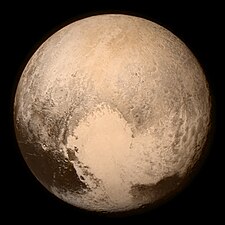










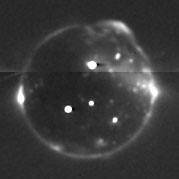
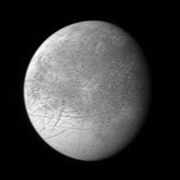

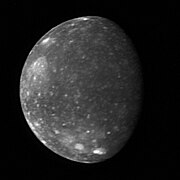
![April 2015: Pluto and Charon – first color image taken by Ralph during AP1 on April 9, 2015[127][133]](http://upload.wikimedia.org/wikipedia/commons/thumb/1/13/PlutoCharon-1stColorImage-NewHorizons-Ralph-20150409.png/150px-PlutoCharon-1stColorImage-NewHorizons-Ralph-20150409.png)
![May 2015: Pluto as seen by LORRI during AP2 from a distance of 75 million km away[134]](http://upload.wikimedia.org/wikipedia/commons/thumb/b/b6/Pluto_by_LORRI%2C_12_May_2015.jpg/150px-Pluto_by_LORRI%2C_12_May_2015.jpg)




